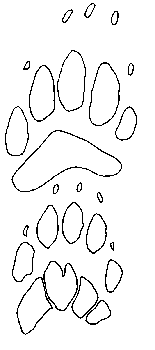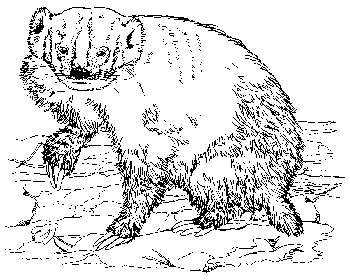American Badger

Texas Critters | Critter Links | Wildlife Fact Sheets
 The American Badger
The American Badger
(Taxidea taxus (Schreber))
The badger is a short-legged, wide-bodied, shaggy-furred member of the weasel family. It has a very distinctive white stripe that extends from its nose to its shoulders. The badger is an excellent digging machine and uses this skill to burrow after it's prey, small mammals, snakes and other reptiles, birds and some insects. Their claws are long and sharp and they have a reputation for ferociousness when attacked. Badgers will hunt in open country and pursue their prey into burrows with amazing speed and power. They have few non-human predators.
 Like another member of the weasel family, the skunk, the badger possesses a scent gland that can emit a strong musk odor that may serve to discourage some would-be predators. The badger is found throughout Texas except for the farthest eastern edge. It occupies a variety of habitats and are most prevalent in the prairie and desert sections of the west. They seem to prefer large tracts of open, uncultivated ground. While hunting burrowing animals, badgers are occasionally out-maneuvered by "wily" coyotes. As badgers dig after rodents, coyotes will wait and snatch the escaping prey above ground, leaving badgers with just a glimpse of what might have been for dinner.
Like another member of the weasel family, the skunk, the badger possesses a scent gland that can emit a strong musk odor that may serve to discourage some would-be predators. The badger is found throughout Texas except for the farthest eastern edge. It occupies a variety of habitats and are most prevalent in the prairie and desert sections of the west. They seem to prefer large tracts of open, uncultivated ground. While hunting burrowing animals, badgers are occasionally out-maneuvered by "wily" coyotes. As badgers dig after rodents, coyotes will wait and snatch the escaping prey above ground, leaving badgers with just a glimpse of what might have been for dinner. The badger is a solitary animal except in mating season which occurs summer and early autumn. Implantation of embryos is delayed until around December to February. Young are born around March and April and remain with the mother until the fall when the family scatters.
The badger is a solitary animal except in mating season which occurs summer and early autumn. Implantation of embryos is delayed until around December to February. Young are born around March and April and remain with the mother until the fall when the family scatters.
Agriculture, development, and poisoning campaigns aimed at other mammals have all greatly impacted badger populations. They are important because they help control rodent populations and may eat insects that cause disease and harm crops. Historically, badger furs were used by Native Americans and later for shaving brushes.